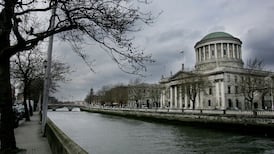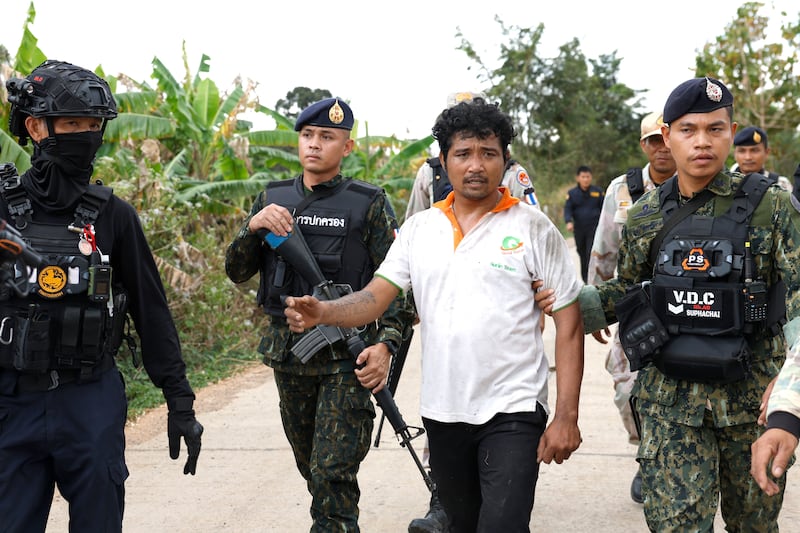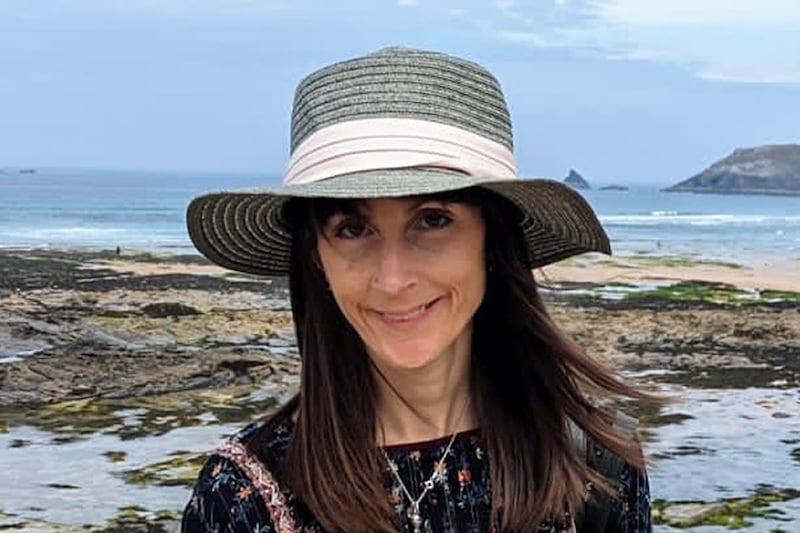Propped on a stool drinking cider at the bar of the Coachman's Inn on New York's Katonah Avenue in the Bronx in 2014, Aaron Brady thought back to the night a year before when he had killed Det Garda Adrian Donohoe.
Under the red, white and blue of the American flag, and to the tune of Irish rebel songs, he longed to share his drunken self-pity. The only available ear belonged to bartender Daniel Cahill.
“Have you ever killed anyone?” Brady asked Cahill.
As evening turned to darkness and the drinking continued into the small hours, Brady shared more of his sorrow. He could never go home. “You wouldn’t know what it’s like to do the things I’ve done,” he told the barman.
- Listen to this and other audio articles by visiting Noa (News Over Audio)
It was not the first time Cahill had heard similar words from Brady. Previously, during another intoxicated evening, Brady had been punched in a bar brawl, suffering a large gash over his eye.
He ran to the bathroom, a trail of blood following him. In the cramped single toilet cubicle, Brady went from crying to fuming as he washed blood from his face and hands.
Staring into the mirror he said, over and over, “I’m going to kill him, I’m going to shoot him.”
He had shot a garda before and he would shoot the man who punched him. It was a stupid thing to mess with Aaron Brady, he boasted.
Irish community
Brady was known among the Irish community in Woodlawn in New York and throughout the Irish bars lining Katonah Avenue as “the guy who shot the garda”. It was no secret. Others had heard him say it, but chose not to testify.
Some spoke of being “terrified”. Much of the information gathered by gardaí was kept from Brady due to a fear of a threat to the lives of the people who had given it. That decision was upheld by the trial judge, Mr Justice Michael White.
Brady wore the moniker of "cop killer" with pride, it made him feel like a real gangster. "The biggest gangster in Ireland", and "the most feared man in Ireland", as he boasted in front of flatmates and Molly Staunton, the girlfriend of one of them, on one drunken evening.
Brady not only failed to keep his crime a secret while he was in America, he sought people out to tell them. At parties, in bars, at weddings he boasted out loud that he was the man who had killed the garda.
Cahill was driving home one evening when Brady flagged him down to show him a newspaper article with a headline calling him a “garda killer” and saying he was “living it up” in New York.
The bartender was not interested. He was not Brady’s friend. But Brady had sought him out, longing for the notoriety. Cahill comes from Dublin 13, growing up a few doors from the infamous brothers, Vincent and Alan Ryan, of the Dublin Real IRA.
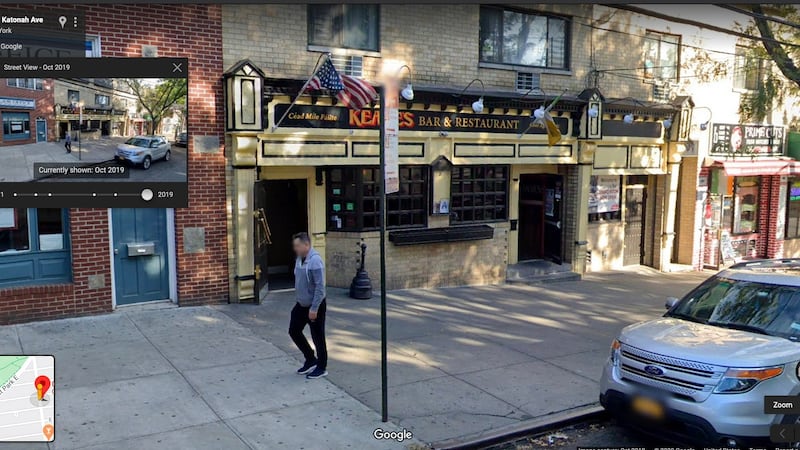
Both of the Ryan brothers were murdered in separate shootings. Cahill counted among his former friends Dean Evans, who is serving a life sentence for murdering dissident republican Peter Butterly outside the Huntsman Inn in Gormanston, Co Meath, in 2013.
But Cahill was not sympathetic to what Brady had done and in July 2019, when US Homeland Security officials knocked on his door, he agreed to give a statement to gardaí using Brady’s own words to incriminate him. It was a breakthrough for investigators.
Crossmaglen
Brady's story begins earlier, and elsewhere. He is a native of staunchly republican south Armagh. A decent Gaelic footballer, he played for Crossmaglen Rangers. His father, Tony, is a physiotherapist for the team and a former club chairman.
The “atmosphere” of south Armagh was mentioned repeatedly during the trial, with gardaí admitting that people along the Border are slow to talk. People can be killed for doing so, Det Insp Martin Beggy said during the trial.
Brady met Suspect A at school, and they became best friends. Suspect A's family owns a business in Boston, which Suspect A now runs.
As a young man Brady did odd jobs here and there. He started as an apprentice electrician having left school aged 16, but did not finish the course. He claimed to have worked as an advertising salesman with his father.
Some time in 2012 he got involved with local fuel launderers and his associates were known to carry out “creeper burglaries” whereby they would steal car keys from people’s homes and make off with vehicles.
One of his friends, known as Suspect B, is suspected of involvement in a robbery of the Lordship Credit Union in August 2011 which netted €22,500 – the same credit union where Det Garda Donohoe was subsequently killed.
The same man is a suspect for a robbery in 2011 at Dundalk Race Course. He is currently before the courts regarding other charges. The simple success of the 2011 Lordship robbery prompted Brady and the others to do it again.
By 2013, Brady was well known to Dundalk gardaí, particularly after he pleaded guilty before the Circuit Criminal Court to ramming three taxis and a Garda van while driving a stolen car there on October 2nd, 2011.
It was shortly after 4am when Brady pulled up alongside Insp John Moroney, a sergeant at the time. Brady stuck his middle finger up at the sergeant before speeding off around the town centre.
Among the many lies Brady told was a claim that the Garda van had rammed him. He lied, too, about Moroney, telling the jury that the inspector had lied to a judge during a previous case and been rebuked.
He was forced to retract that claim when the prosecution read back a transcript which showed clearly that the inspector had not lied, nor had he been rebuked.
Jessica King
In September 2012, Brady met Jessica King. He was so in love that he tattooed the date of their first meeting on his back. Text messages between them in the run-up to the robbery were pored over in court, since they were important to both prosecution and defence.
Defence counsel Michael O’Higgins argued that they showed that Brady was not “an uncaring psychopath”, pointing to his regular professions of love for King and his pleas to her after they had a row on the Thursday night before the raid.
She had gone out with friends to Ridley’s nightclub in Dundalk and when Suspect A and Brady picked them up, she was wearing another man’s baseball cap. Overwhelmed with jealousy, Brady stormed off. He spent much of the day after apologising by text.
She knew he was involved in fuel-laundering, but would have nothing to do with him if he was involved in more serious crime. One night, she told the court, a friend of Brady’s had told her in a Dundalk nightclub that Brady had stolen a car.
She was upset and demanded an explanation. Brady denied it, saying Suspect A had stolen it. In court, Brady denied that, saying that he would never have said that Suspect A stole cars.
“He has owned his own house since he was 18 years old and is working in America making a six-figure sum. [Suspect A] is a wealthy man. What would he be doing robbing cars or getting involved in armed robberies?” Brady said.
But King had no reason to lie and her memory was clear. From text exchanges with King, it was apparent that Brady was helping her to buy a car and that he had told her he would have the money by the weekend.
This, the prosecution said, showed expected money from a successful Lordship raid. Brady, however, told the jury that the diesel-laundering yard had been busy and that he would get €300 for a couple of hours loading cubes of diesel waste.
Brady’s texts with King also provided part of his alibi. He told her at least twice on the night of the killing that he had work from about 8pm and it would take him 90 minutes to two hours, asking for permission to call over once he was finished.
By “work”, King said she understood he meant fuel-laundering. The prosecution argued the texts sent by Brady were a “ruse” to fool his girlfriend because Brady knew she would break up with him if he was involved in armed robbery.
Despite Brady’s claims that he could earn easy money, the prosecution insisted that he needed cash and that he had decided to get it by helping to rob the credit union’s Friday night takings .
Three nights before the robbery the gang stole a Volkswagen Passat in Clogherhead, Co Louth, from outside a house, after cutting out the barrel of the lock on the front door of the house and stealing the car keys. The car's owner woke to find his front door open.
Response times
Four days before the robbery, Suspect A and Suspect A’s brother called gardaí to Suspect A’s parents’ house, which is less than 2km from Lordship, saying intruders had been spotted.
Gardaí searched, but found no evidence of intruders and no sign of footprints on the wet grass. It was, the prosecution argued, a ruse to check how long it took gardaí to respond to calls in rural north Co Louth.
The prosecution also claimed that Suspect A’s car drove past Lordship Credit Union hours before the raid with the passenger side-window down in what they dubbed a “scoping” exercise.
By the evening of January 25th, 2013 the robbers were ready. At about 8.48pm, four men were seen on CCTV getting out of the stolen Passat behind Lordship Credit Union, spending 40 minutes in a laneway on a freezing, stormy January night.
Gardaí believed they had sheltered in a nearby shed, but no useful forensics were found. Mobile phones were switched off to avoid being traced. Walkie-talkies were used to communicate with one another and the driver of the Passat.
Meanwhile, Det Garda Donohoe and his colleague, Det Garda Joe Ryan, as usual on Friday nights, accompanied workers from four rural credit unions from Omeath, Carlingford, Cooley and Lordship on Louth's Cooley peninsula.
Friday was the credit unions’ busiest day. In the 2011 raid, the robbers took €22,500 from an employee sitting in his car waiting for the Garda escort. Since then, employees stayed in the credit union until the escort arrived.
Garda Tony Golden, who would be shot dead two years later in the line of duty, was part of the Garda escort until they got to Cooley. There, detectives Donohoe and Ryan took over.
Armed with Sig Sauer service pistols, the gardaí headed towards Lordship with one credit union car ahead of them containing €17,000. They arrived at Lordship at about 9.25pm. There, credit union official Pat Bellew emerged with the day's €7,000 takings.
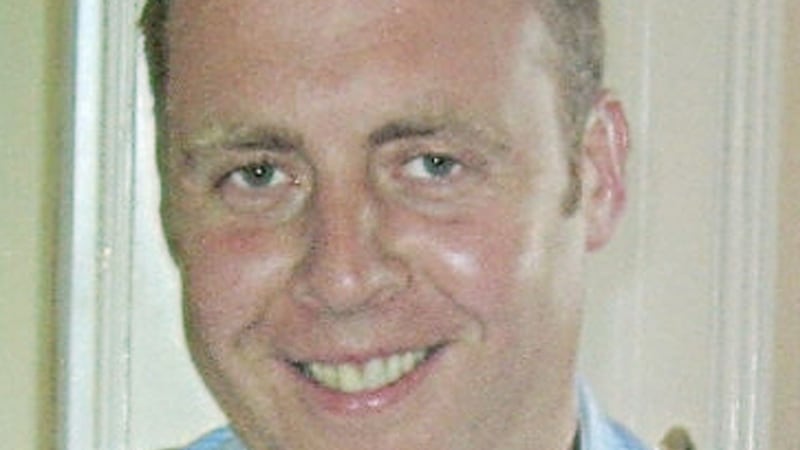
Bellew got into his gold-coloured Mazda, preparing to join the other credit union car and the Garda escort, driven by Ryan. However, they were blocked by the stolen Passat. Four men dressed in black and balaclavas jumped over the wall. Two were armed.
Brady had a shotgun, another man was armed with a handgun. The gunmen went directly for the Garda car while the others, armed with a hammer, went for what they thought were the cars carrying the money.
As the raiders approached, Det Garda Donohoe jumped out of the passenger seat of the Garda car. He was shot in the face with a single shotgun round from 6ft away, before he had even drawn his weapon. He died instantly.
CCTV showed the moment the gun was fired, with the gunman almost falling to the ground because of the weapon’s recoil. The gunmen then turned their attentions to Det Garda Ryan: “We will f***ing kill you, don’t move, I will shoot you,” screamed one.
The other raiders took the €7,000 off Bellew, but they did not target the car containing the €17,000 from the other credit unions. Instead, they went to a fourth car belonging to Lordship volunteer Bernadette McShane.
She broke down as she gave evidence last February. Having seen the garda being shot, she said: “At that stage, when I saw the man running towards me, I thought he was coming to kill me because I had seen too much.”
The entire incident lasted 58 seconds. By 9.30pm they were gone. Det Garda Ryan had been unable to clearly identify the raiders, thinking one was 6ft 1in tall, whereas Brady is 5ft 7in. They had Border accents, he said. One had a walkie-talkie, at least.
A number of people saw the Passat and at least two other cars driving off at speed towards the Border minutes after the robbery. But in the immediate aftermath investigators had little to go on.
Usual suspects
Told by Det Garda Ryan that the raiders had Border accents, Det Insp Pat Marry (now retired) asked for a list of locals who might be involved. Suspect B, a suspect for the 2011 Lordship robbery, was quickly on it. So, gardaí looked for Suspect B’s connections.
At around 1pm the day after the robbery, Insp John Moroney, who was then a sergeant, was leading a search of roadside from Lordship when he spotted Aaron Brady in the passenger seat of his best friend's distinctive BMW.
Moroney knew Brady from the Dundalk car-ramming case two years before. He separated Brady from the driver and asked both to account for their movements the previous night.
Sitting on a barrier, Brady calmly lied, saying he had gone to his girlfriend’s house at about 8pm and stayed there until 3am, including things he had done the Thursday before and other things that he just made up. He also gave a fake phone number.
Suspect A gave a conflicting account. The inspector was suspicious, noting that Brady had told him that he did not hear about the shooting until that morning, which was strange since Brady was staying at Suspect A’s house - just 2km from Lordship, so close that it was inside the Garda cordon.
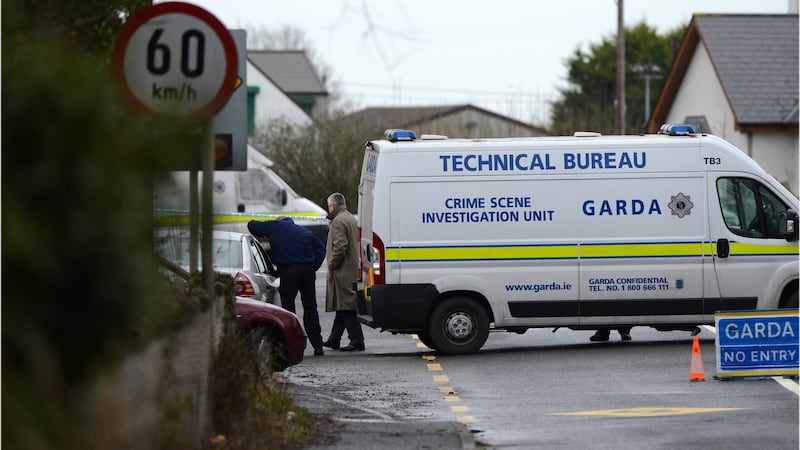
Brady would make much of this when he got into the box, insisting that it was “ridiculous” to suggest that he had said he did not know what had happened until that morning. He said Moroney was either mistaken or acting out of “malice”.
Within an hour of Brady giving that first false account, Police Service of Northern Ireland officers had called to King's house. She lied to protect Brady because she thought he had been laundering diesel.
She would later correct her statement and say that Brady arrived at her house after 11pm and left at about 3am, when he was picked up by Suspect A.
A day after the robbery, wildlife ranger Donald Whiteside came across a still-smouldering car on Cumson’s Road in south Armagh, a laneway off a country road in quiet farmland.
Finding burned-out cars is not uncommon, so he waited until Monday to report it. Once he did, PSNI gathered forensics from the ashes and debris, and collected litter from the surrounding ground.
Although nothing was found of forensic value, the car chassis number had survived. With that, gardaí quickly identified it as the Passat stolen outside Clogherhead in the early hours of January 23rd.
In the days afterwards, Brady acted normally. He was seen on CCTV at a local bookies on the Saturday, meeting up with friends. On Sunday he went to the cinema with Jessica King, Suspect A and Suspect A’s girlfriend.
Social media
Brady was being linked to the murder on social media. Worried, his father, Tony Brady arranged for his son to go to a Garda station to give a voluntary statement. They called on Crossmaglen-based solicitor Daniel McNamee, who advised Brady not to do so if he had had anything to do with it. However, Brady went on February 5th, 10 days after the killing.
More than six years later, shortly before the trial, Brady's lawyers sent a new alibi - saying that he had been in the Concession Road yard throughout the time of the robbery and shooting.
Brady spoke to Insp Mark Phillips and Det Garda Jim McGovern of the National Bureau of Criminal Investigation. However, when it came to the crucial hours after 8pm, his solicitor asked for a private consultation because he realised Brady was not telling gardaí the same story he had told him.
Following this, McNamee told the detectives that his client was involved in laundering diesel that night and wanted to know if it was all right for him to talk about this. The gardaí told him they were only interested in Det Garda Donohoe and agreed to take an “off the record” statement about Brady’s involvement in diesel laundering.
Brady told them that he arrived at the Concession Road yard around 8pm to load diesel waste. He had spent about 15 minutes trying to start a forklift, but gave up when it would not start and headed to a friend’s house on nearby Lough Road.
Alibi
This would become one of the most controversial aspects of the case. More than six years later, shortly before the trial, Brady’s lawyers sent a new alibi - saying that he had been in the Concession Road yard throughout the time of the robbery and shooting.
Brady later elaborated in a written note sent to the DPP in which he said he lied to gardaí in his 2013 voluntary statement because he did not want to implicate himself in diesel laundering.
He had in fact, he then claimed, been able to start the forklift and spent 90 minutes loading waste before travelling to Lough Road, and then onto his girlfriend’s house. That would have put him at Concession Road until after 9.30pm, the time of the robbery.
Explaining the late alibi, defence counsel Michael O’Higgins said they had waited for disclosure, saying it would be “hideous” to expect a lawyer to advise their client to submit an alibi before seeing the prosecution’s evidence. The prosecution accused Brady of “sculpting” his alibi around what he knew from prosecution disclosure.
Brady, Suspect A and the Passat
In one of the biggest Garda investigations in the State, CCTV footage from 380 locations all over Louth and south Armagh was examined, while thousands of pages of reports were produced for, and by detectives.
One piece of CCTV footage, which was not very clear, from a house near Suspect A’s parents’ home showed a car leaving Suspect A’s house around midnight on the night the Passat was stolen.
Within minutes Suspect A was seen arriving at a nearby service station in his distinctive BMW, with its alloy wheels and vinyl-wrapped roof. Suspect A and his brother bought petrol and Lucozade and drove off.
Two phones belonging to Brady, and phones belonging to Suspect A and Suspect B, were active until about one hour before the robbery. Then they went silent for two hours.
There was at least one other person in the car. Phone records proved that man was Brady, said the prosecution. A similar car was identified later that night in Clogherhead, trying, gardaí believed, to identify a car that could be stolen for the raid.
Two cars consistent with Suspect A’s BMW and the stolen Passat were later identified travelling north from Clogherhead towards Dundalk on back roads, rather than the M1. A car arrived back at Suspect A’s house at 5am. The Passat was safely hidden away.
In the witness box, Brady said he could not remember where he stayed the night the car was stolen. However, it was apparent from mobile phone evidence and photos found on Jessica King’s phone that Brady had not left Suspect A’s side throughout that period.
Among the circumstantial evidence put forward by the prosecution was the fact that two phones belonging to Brady, and phones belonging to Suspect A and Suspect B, were active until about one hour before the robbery. Then they went silent for two hours.
Suspect B’s phone also appeared to be frantically trying to contact Brady minutes before the phones went dead, suggesting Suspect B was anxious to find Brady at, or near the rendezvous point in Lordship.
Circumstantial evidence
Witness Douglas Hughes linked Brady indirectly to where the Passat was burned. Six months before the Lordship raid, he was woken by a van passing his home at the corner of Chaleybeate Road and Cortamlat Road in Co Armagh.
Hughes jumped out of bed and drove up the road because he knew by the sound of the van “straining” to get up the hill and the hour of the morning that it was probably fuel launderers dumping waste.
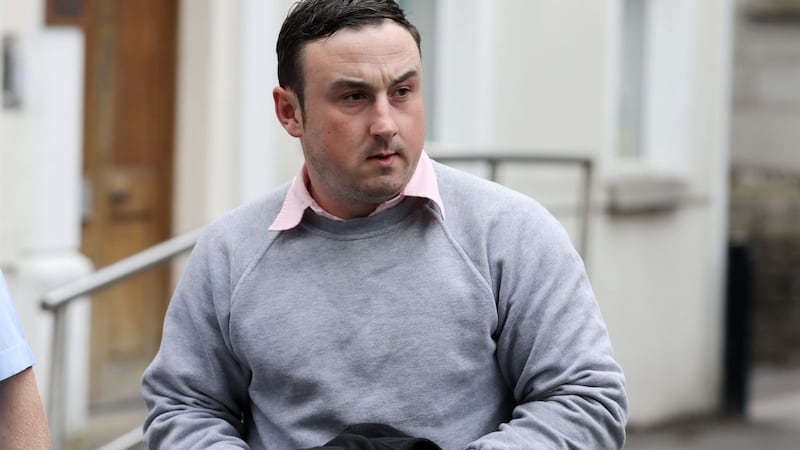
On Cumson’s Road, he saw a white Transit van and two men dumping the cubes. When they saw him they drove off. After giving chase, he reported the van’s registration to gardaí. The van was later pictured at the fuel-laundering yard, and Brady admitted to having driven it.
Farmer Alan McBride bolstered the suggestion that Suspect A’s car was used in the robbery when he said he saw a dark-coloured Volkswagen followed by a BMW 5-Series driving at high speed past his farm shed on Chaleybeate Road within 30 minutes of the robbery. Twenty minutes later the BMW returned on its own.
New York
Having given voluntary statements in February 2013, Brady told gardaí that he would be ready to talk again. Instead, he applied for a British passport and flew from Belfast to Newark, New Jersey, on April 13th, 2013 under the 90-day visa waiver programme.
There, he was picked up at the airport by Suspect A and travelled to Boston to work for his friend’s firm. However, he was still trying to maintain his relationship with Jessica King, who moved to New York in 2014.
Around Valentine’s Day that year, instead of taking care of his friend’s business, Brady drove to New York to be with her. He fell out with Suspect A as a result. During his evidence, he said they have not spoken since.
Brady said he had had a great life in New York. His relationship with King ended, but he said he was making $65/hour working on building sites and got time-and-a-half for working more than 40 hours weekly.
In late 2015, Brady met Danielle Healy, an American citizen, and quickly began a relationship. She became pregnant within weeks of their first meeting and they decided to move in together. They have since married.
However, Brady soon realised that Insp Mark Phillips and Det Garda Jim McGovern were working with US Homeland Security in New York to find anyone who might have heard him admit to the Donohoe killing.
Six people gave statements, but the only two who actually gave evidence in court were Molly Staunton, who had started a relationship with one of Brady's flatmates in 2016, and Cahill. It was their evidence that identified Brady not just as one of the robbers, but as the killer.
Molly Staunton
In July of that year, Staunton said she was in her then-boyfriend's apartment when Brady emerged from his bedroom and went on what she called a “huge rant”.
He was distressed, saying he wanted to be a good father and worried that he would not be able to care for his soon-to-be-born son. She said he said that he had “had to carry around the guilt of having murdered a cop in Ireland” and that he “was the most feared man in Ireland”.
Staunton was described as unreliable by Brady’s defence. During cross-examination, she agreed with defence counsel Fiona Murphy that Brady had not confessed to shooting anyone, but had been upset because he was being linked to the murder.
When the prosecution showed her video footage of her own statement to gardaí she reverted to her original position. Staunton gave her testimony from her home in New York because Covid-19 restrictions meant that no public buildings were available.
While she was giving her evidence she was twice interrupted by a man who told her to “tell them what you’re supposed to tell them”. During the second interruption, which happened in front of the jury, he told her “no more testimony” and the video link went dead.
Brady’s lawyers asked for the jury to be discharged following the interruption and the suggestion that she may have been interfered with while giving evidence is likely to be a grounds for appeal.
Daniel Cahill
Brady's defence lawyers attacked Cahill's credibility. They suggested – solely on the basis that he had known the now-dead Ryan brothers – that he had been a member of the "Ryan Crew" or Dublin Real IRA before leaving Ireland in 2013.
Cahill strongly denied this. The trial judge later said it was an “outrageous” suggestion that should never have been put to the witness by barrister Justin McQuade, who apologised, said he had overstepped the mark, and moved on.
McQuade later accused Cahill of breaking into Brady's New York apartment and threatening to cut off Brady's toes with a Stanley knife. Cahill strongly denied any involvement in the break-in, or assault.
Throughout the trial, during lengthy legal argument and in front of the jury, the defence argued that Cahill may have given testimony so that the Department of Homeland Security would allow him to remain in America, even though he was there illegally.
Part of the basis for the defence's claim was a conversation between Suspect A and special agent Matt Katske of Homeland Security at Belfast Airport on June 6th, 2017, which had been secretly recorded by Suspect A or his girlfriend.
In it, the special agent can be heard talking about Suspect A’s brother, saying: “He’s being removed, he’s going home. I can find plenty wrong with his paperwork. If he puts Aaron Brady away, you will probably never hear from me again... I can’t do anything for him until he commits to doing something for us in this case.”
The defence argued that the jury should hear the recording so they could consider whether something similar had been said to Cahill before he made his statement to gardaí in July 2019 after he had been detained by Homeland Security.
The trial judge refused, ruling that it had been dealt with by the denials of Daniel Cahill and special agent Mary Ann Wade of Homeland Security who told the jury that she made no promises or offers to Cahill.
During legal argument, it emerged that an associate of Brady’s had contacted Cahill to ask if he had spoken to gardaí before the prosecution even disclosed to the defence that he had given a statement.
Brendan Grehan for the prosecution said there was evidence that Brady had “boots on the ground” in New York and one man in particular was suspected of relaying information from the US back to Brady. Numerous witnesses had been contacted, said Grehan.
On June 24th, on the second day of Cahill’s cross-examination, Grehan said he had become aware of “very serious attempts” to intimidate Cahill. However, the witness remained firm, insisting he had heard Brady confess three times.
When Brady got in the box he described Cahill as a “lying psychopath”, a description that Grehan attempted to throw back at Brady, suggesting that he was the one who lacks morality, shows no remorse or empathy, and constantly seeks to blame others.
Contempt
Cahill was not the only person subjected to intimidation. In what Mr Justice White described as "the most outrageous contempt of court" he had ever seen, a video of one witness statement to gardaí was circulated on WhatsApp, Facebook and Youtube.
It was accompanied with text accusing him of “touting” or calling him a “rat” and claiming that he had criminal charges against him dropped as payment. This witness, and his family in Ireland had been subjected to “widespread intimidation”, said Grehan.
In his statement, this man said he heard Brady admit to shooting Det Garda Donohoe. He lives in New York where, due to the extent of the pandemic lockdown, it was not possible for him to be subpoenaed to give evidence.
Another man, who also lives in New York, told gardaí that he heard Brady “boasting” in a pub that he knew what it was like to kill someone. When Brady realised he was there, the man alleged Brady took him outside, assaulted him and warned him to keep his mouth shut. The man was left with a scar over his eye which was photographed by gardaí.
Some months into the trial a solicitor on behalf of this man contacted Insp Mark Phillips of the National Bureau of Criminal Investigation and told him that he would not return to Ireland to give evidence because of outstanding criminal matters in Northern Ireland.
When gardaí suggested that evidence could be given by a New York videolink, the man’s lawyer refused, saying his client had been under “immense duress” when he had spoken previously and would not “voluntarily testify”.
Another witness said his recorded statement to gardaí was not accurate. Two witnesses in Northern Ireland did not come forward despite arrest warrants. One had given, but retracted an alibi for Brady. The other had heard Brady admit to the killing.
Cahill’s evidence
Besides the incident following the bar brawl and the drunken evening when Brady broke down over several hours and admitted to killing a garda in a “robbery gone wrong”, there was a third admission by Brady witnessed by Cahill.
It was some time in 2015 when customers at the Coachman’s invited Cahill to a party. When he arrived, Brady and three other men were “trying to outdo each other” in a “pissing contest” about which of them was the toughest, the barman remembered.
Brady had claimed that he was the only one “who had killed someone”. He said that “everyone around knows who he is and what he had done and the crimes he had committed and this was why nobody wants to get on the wrong side of him.”
Brady, said Cahill, had boasted that it “takes a certain type of person to manage these feelings well”. In his closing speech, prosecuting counsel Staines said such exchanges showed that Brady had worn the killing “like a badge of honour”.
Staines described Brady as a “skilled and practised liar” who had told a “litany of lies” and used the killing to “intimidate and curry influence” in New York, “sometimes crying, lamenting in drink or bragging with his chest puffed out”.
Brady had been confident that nobody would talk. “He was wrong about that. Not all the people he talked to about this were willing to turn the other way. Two came to give evidence.”
Each piece of circumstantial evidence against Brady could be a coincidence, Staines told the jury, but “when coincidence is put on top of coincidence” there “comes a point that it is an affront to common sense that all these little things are coincidence”.
Defence case
For the defence, O’Higgins told the jury that Cahill’s evidence was “shrouded in mystery” and that he may have been subjected to threats or inducement by Homeland Security.
Counsel asked the jury to consider why, five years after Cahill first claimed to have heard Brady confess, he “falls out of the sky with this evidence” on July 25th, 2019, in his first statement to gardaí.
The catalyst for Cahill coming forward was, he said, “an early morning knock on the door” by Homeland Security officers, which had led Cahill to run naked into the attic, where he stayed for hours.
Steroids and a suspected cannabis plant were found in the apartment, but no charges were brought even though Cahill had overstayed his visa. Immigration lawyer Kerry Bretz said he had never seen that happen during a 30-year career.
O’Higgins insisted there was evidence that his client had been at the Concession Road yard at the time of the murder and gardaí had ignored evidence supporting that. The prosecution had come to court with a sculpted case that editorialised the evidence.
Jury’s decision
Ultimately it was up to the jury to decide. They were faced with many choices. They could find Brady guilty of capital murder, guilty of ordinary murder, guilty of manslaughter or not guilty. They also had to decide whether he was guilty in relation to the robbery at Lordship.
They found, by a majority of 11 to one, that the prosecution had proven beyond reasonable doubt that Brady was guilty of the capital murder of Det Garda Donohoe, a crime that carries with it a mandatory sentence of 40 years’ imprisonment.
- Listen to this and other audio articles by visiting Noa (News Over Audio)


